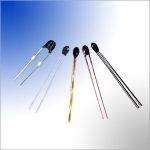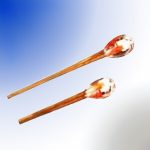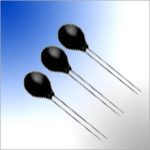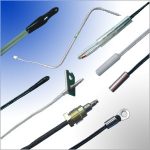NTC Thermistor for Temperature Measurement and Control Selecting Reference Information
The high sensitivity of an NTC thermistor makes it an ideal candidate for temperature sensing applications. These low-cost NTC thermistor sensors are normally used for a temperature range of -40C to +300C.
Selection criteria for NTC thermistors are
- Temperature range
- Resistance range
- Measuring accuracy
- Environment (surrounding medium)
- Response time
- Dimensional requirements.
Attention for Application of NTC Thermistor for Temperature Measurement and Control
- Avoid sudden change of ambient temperature around thermistor and temperature sensor, to avoid aging.
- Current passing through thermistor and temperature sensor may cause thermistor body heating, and cause temperature variation, please take the temperature variation into consideration in selection. (Dissipation coefficient)
- Measurement begins after 5 seconds min, better 7 seconds.
- In requested swift and precision temperature measurement, small size, and little thermal constant part NTC thermistor shall be more suitable.
- Keep away from dusty, wet, humid, corrosive gas, deoxidizing gas, strong vibration condition, or the places where similar hazardous conditions exist.
NTC Thermistor for Temperature Measurement Application Circuit Examples

NTC thermistor in Wheatstone bridge circuit
One of the circuits suitable for temperature measurement is a Wheatstone bridge with an NTC thermistor used as one bridge leg.
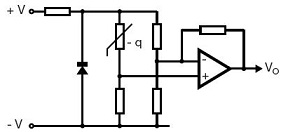
NTC Temperature sensing bridge
Temperature sensing bridge with op-amp which acts as differential amplifier.
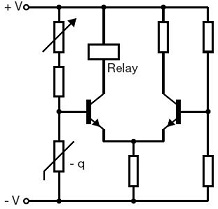
Thermostat Circuit

Circuit diagram of a typical heat detector using a matched pair of NTC thermistors.
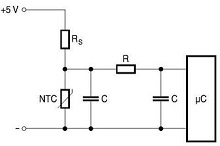
circuit with NTC thermistor microcontroller
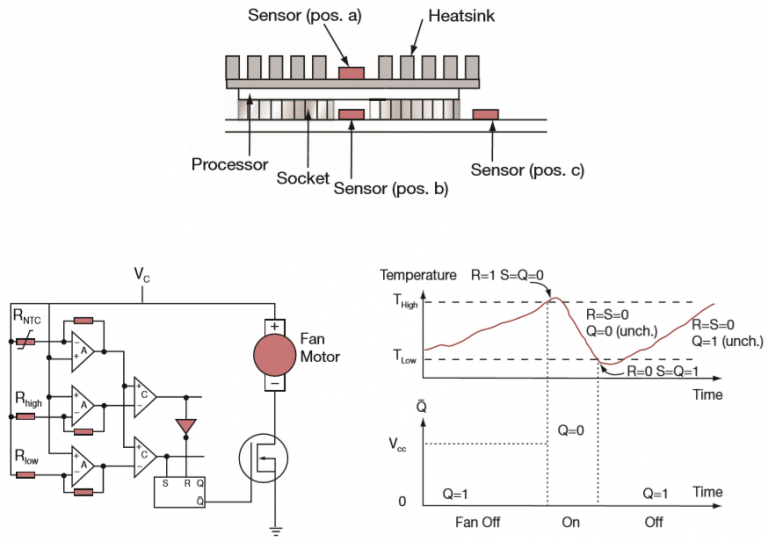
Example of NTC Circuit Protection in PC Cooling Fan
Schematic Drawing of the Charging Control Unit of a Battery Pack Using NTC Thermistor as Temperature Sensors
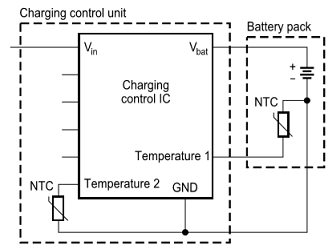
NTC thermistor in Battery Pack smart charging control
All rechargeable batteries and lithium ion batteries in particular must be controlled and protected by smart charging circuits, as the mobile phone drawing power from the batteries must operate in a variety of environments, including low and high-temperature operation.
As preferred temperature detection devices NTC thermistor are used in the protective circuitry. NTC thermistor can detect the ambient temperature for different purposes, depending on the battery system. Especially for quick charging the ambient temperature has to be measured, as not all batteries allow the charging in the hot and cold temperature region. Usually charging temperatures of 0 °C up to 45 °C for slow charging, and 5 °C … 10 °C up to 45 °C for quick charging are recommended by the battery pack manufacturers depending on the battery chemistry.
The NTC thermistor is part of a smart charging control unit, which assures that the ambient temperature is in the range allowing quick charging. During charging the NTC thermistor repeatedly measures the temperature all 5 to 10 seconds and can detect a rise in the battery cell’s temperature at the end of the charging cycle or precipitated from abnormal charging conditions. During discharging NTC thermistor also perform temperature compensation for the voltage measurement, which helps to measure the remaining charge in the battery.
NTC Thermistor Temperature Sensors Used as a Thermal Switch
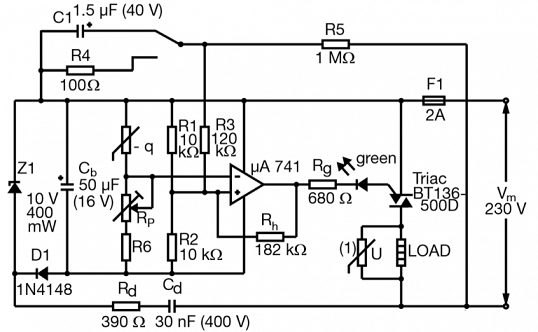
Refrigerator thermostat using an NTC temperature sensor
A common use of an NTC thermistor temperature sensor is in one of the bridge arms of a thermal switch circuit using an operational amplifier such as the μA 741. Following figure shows a typical thermal switch circuit for a refrigerator thermostat. The circuit consists of a 10 VDC zener diode stabilized power supply, a wheatstone bridge (containing the NTC thermistor temperature sensor) and an integrated comparator circuit controlling a triac. The circuit is designed to switch a maximum load current of 2A off at -5C and on at +5C.



